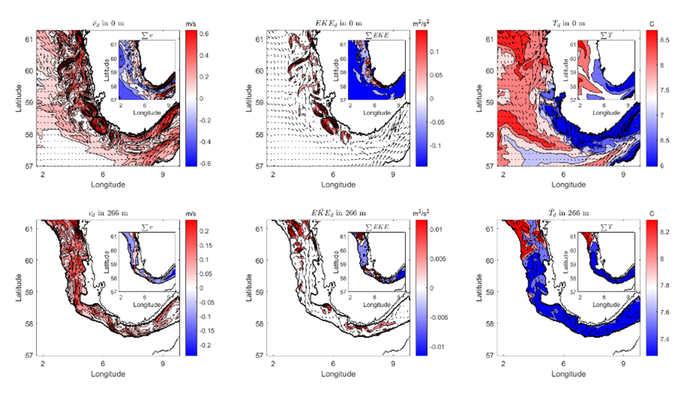A. Enge1*, J.D. Pietrzak1, F. Mienis2, P. Kraal2, B.C. van Prooijen1
1 Delft University of Technology, Netherlands; 2 NIOZ, Netherlands
* Corresponding author: a.enge@tudelft.nl
Introduction
The Norwegian Trench is a major canyon that cuts through the North Sea off the Norwegian coast. It is well known as the main depositional area of the North Sea. As one of the three major inflow pathways of Atlantic water into the North Sea, the Norwegian Trench plays a key role in the exchange of water masses e.g.Norwegian Coastal Current (NCC) and Atlantic Water (AW) and in the regulation of salinity in the North Sea. Within the trench, mesoscale eddies are observed. These eddies induce high temporal and spatial variability in the exchange processes of the trench. We investigate how these eddies are generated and how they influence sediment resuspension by locally induced high current velocities above the seafloor.
Objective and Methods
We use Copernicus Marine Service (CMEMS) model data and unique Conductivity-Temperature-Density (CTD) observations of the trench taken aboard the research vessel Pelagia between 26 May and 14 June of 2023. The observations are used to validate the model outputs of temperature and salinity. Daily mean model data from 2022 are used to obtain spatial and temporal high reolution information about current velocities and water mass properties. Eddy kinetic energy (EKE) distributions and eddy tracking tools provide the information needed to characterise different energy regimes in the trench and provide insight into erosion hot-spots within a depositional canyon.
Results
From the T-S plots we can see that the model data is capable to represent the discrete observations accurately and in sufficient detail for this study. We see that the strong generation of anticyclonic eddies at 58-59° N correlates with the presence of the topographic ridge that cuts into the trench from east to west. The ridge retroflects the warm, saline AW so that it subducts below the NCC. This can lead to baroclinic instabilities at depths of > 100 m and the generation of anticyclonic subsurface eddies. Cyclonic eddies dominate near the western shelf. The appearance of eddies at the head and mouth of the trench may be due to the influence of canyon dynamics e.g. upwelling and downwelling. The formation of the cyclonic eddies at 61° N could be caused by the southward inflow of AW on the western side of the trench. Preliminary results show that high current velocities are mainly observed at the edges of mesoscale eddies (Fig.1). The mesoscale eddies decay on daily timescales which makes the flow within the Trench highly variable. However, some regions are prone to enhanced bypassing/generation of Eddies and are more likely to experience erosion conditions.

Fig. 1: Daily mean current velocities (v_d), EKE and temperature at the surface and at 266 m depth for a randomly selected day in January 2022. The small plots show the distributions summarized over January 2022. The arrows show the mean current velocity with flow direction.


